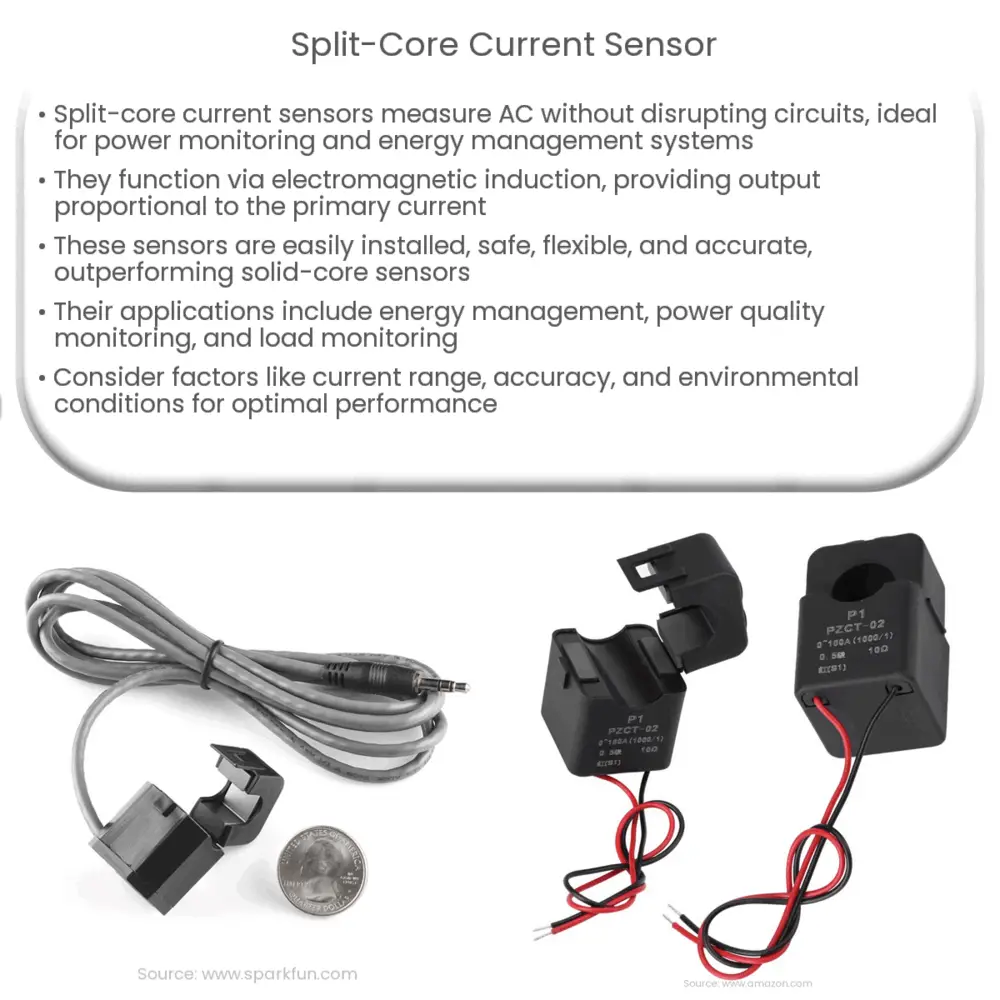A split-core current sensor is a non-invasive device for measuring AC in conductors, offering easy installation, safety, accuracy, and flexibility.

Split-core Current Sensor: An Introduction and Overview
What is a Split-core Current Sensor?
A split-core current sensor, also known as a split-core current transformer, is a versatile and highly effective electrical device used for measuring alternating current (AC) in a conductor without the need to disconnect the conductor or interrupt the electrical circuit. It is commonly used in power monitoring applications, energy management systems, and electrical distribution systems to provide accurate current measurements and enable safe, non-invasive monitoring of electrical loads.
How Does a Split-core Current Sensor Work?
Split-core current sensors work on the principle of electromagnetic induction. They consist of a magnetic core, typically made of ferrite or iron, which is split into two halves and designed to be clamped around a conductor. As AC flows through the conductor, it generates a magnetic field that induces a current in the magnetic core. This induced current is then transformed into a secondary current or voltage output by the sensor’s built-in secondary winding, which is proportional to the primary current flowing through the conductor.
The ratio of the primary current to the secondary current is known as the “turns ratio,” which is a crucial parameter in determining the accuracy and sensitivity of the sensor. The output can be easily connected to monitoring equipment, such as data loggers, meters, or control systems, to provide real-time information about the current flow in the conductor.
Advantages of Split-core Current Sensors
Split-core current sensors offer numerous benefits over traditional solid-core sensors, which require the conductor to be disconnected and threaded through the sensor for installation. Some of the key advantages of split-core sensors include:
- Easy Installation: Split-core sensors can be easily installed or removed without interrupting the electrical circuit or disconnecting the conductor. This feature makes them ideal for retrofit applications and temporary installations.
- Safety: As there is no need to disconnect the conductor during installation, split-core sensors minimize the risk of electrical hazards and reduce downtime. This is particularly important in high-voltage and high-current applications where safety is paramount.
- Flexibility: Split-core sensors are available in various sizes and specifications, making them suitable for a wide range of applications. They can be used with conductors of different shapes and sizes, and can measure currents ranging from a few milliamperes to several kiloamperes.
- Accuracy: High-quality split-core sensors provide accurate and reliable current measurements, often with an accuracy class of 1% or better. This makes them suitable for demanding applications, such as energy management and power quality monitoring.
Applications of Split-core Current Sensors
Split-core current sensors find use in a wide variety of industries and applications. Some common use cases include:
- Energy Management Systems: Split-core sensors are used in energy management systems to monitor energy consumption, identify inefficiencies, and optimize energy usage in commercial and industrial settings.
- Power Quality Monitoring: By providing accurate current measurements, split-core sensors help detect power quality issues such as harmonics, voltage fluctuations, and power factor problems in electrical systems.
- Submetering: Split-core sensors can be used in submetering applications to measure and monitor energy consumption for individual tenants or departments in multi-tenant buildings, enabling fair allocation of energy costs.
- Load Monitoring: In electrical distribution systems, split-core sensors can be used to monitor the load on transformers, motors, and other electrical equipment to prevent overloading and ensure efficient operation.
- Protection and Control: Split-core current sensors can be integrated into protection and control systems, such as relays and circuit breakers, to provide real-time current measurements and enable fast response to potential faults or abnormal conditions.
Selecting the Right Split-core Current Sensor
When choosing a split-core current sensor for your application, it is essential to consider several factors to ensure optimal performance and compatibility. Some key considerations include:
- Current Range: Select a sensor with a suitable current range for your application. Ensure that the sensor can accurately measure both the maximum and minimum currents expected in the system.
- Accuracy: Consider the accuracy requirements of your application and choose a sensor with an appropriate accuracy class. High-precision sensors may be necessary for energy management and power quality monitoring applications.
- Physical Size: Ensure that the sensor’s core is large enough to accommodate the conductor, but not too large to compromise measurement accuracy. Check the sensor’s dimensions to verify that it fits in the available space.
- Output Type: Choose a sensor with the appropriate output type (current or voltage) for your monitoring equipment. Some sensors also offer additional features, such as adjustable output levels or built-in signal conditioning.
- Environmental Conditions: Consider the environmental conditions, such as temperature, humidity, and vibration, in which the sensor will be installed. Select a sensor with appropriate environmental ratings and protection features to ensure reliable operation and longevity.
Conclusion
Split-core current sensors offer a convenient, safe, and accurate solution for measuring alternating current in various applications. With their easy installation, flexibility, and high performance, they have become an essential tool in energy management, power quality monitoring, and electrical distribution systems. By selecting the right sensor for your application and considering factors such as current range, accuracy, physical size, and environmental conditions, you can ensure optimal performance and reliability in your current monitoring tasks.

